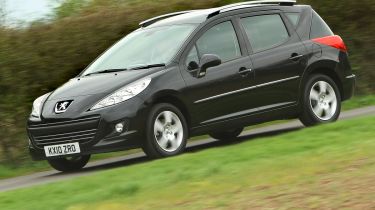Peugeot 207 SW (2007-2012) review
The Peugeot 207 SW is a spacious and practical supermini estate with a reasonably well built interior and a wide choice of engines

The Peugeot 207 SW is one of the strongest choices on the supermini estate market, where it rivals the Renault Clio Sport Tourer, Skoda Fabia Estate and SEAT Ibiza ST. The SW builds on the strengths of the standard Peugeot 207 – a decent-quality interior, good driving experience and wide range of engines – by adding much more space and practicality. The boot is large and enhanced by clever additions to make loading luggage easy. Plus, the 207 SW is as comfortable and agile on the road as other versions of the Peugeot 207.
Our choice: 1.6 HDi 92 Sport
Engines, performance and drive
Even though it’s 119mm longer than a standard 207 hatchback, the Peugeot 207 SW feels much the same from behind the wheel. That means an excellent balance between ride comfort and cornering ability. Precise steering adds to the appeal, while buyers have a wide range of petrol and diesel engines to choose from. The 1.4 and 1.6-litre petrol engines can become a little noisy at high revs, though, so the responsive and efficient diesels are better options. Trouble is, the manual gearbox is a real letdown; it has a slack and vague feel, and is utterly unsatisfying to use, which takes the edge off the driving experience.
MPG, CO2 and Running Costs
When compared to its Renault Clio Sport Tourer and SEAT Ibiza ST rivals, the Peugeot 207 SW looks decent value for money, with the entry-level models costing less. Just bear in mind that these Access-spec cars aren’t that well equipped – you need to go for an Active model to get essentials like air-con and Bluetooth. Go for a higher-spec Allure, and alloy wheels and rear parking sensors are standard – the latter are always useful on an estate. As always, diesel is the best option for buyers wanting low running costs, although no version emits less than 100g/km of CO2 for free road tax. Still, Peugeot’s Just Add Fuel package takes the hassle out of servicing, insurance and breakdown cover costs.
Interior, design and technology
From the nose back as far as the B-pillars, the Peugeot 207 SW looks more or less identical to any other 207. But an extended roofline, complete with roof rails, hints at the practicality within. At the rear, the tailgate has a large glass area – which opens separately – with reverse-angled C-pillars, and it all adds up to quite an attractive package. The dashboard design is identical to that of the 207 hatchback, and feels reasonably well put together, but Access models are sparsely equipped. Active-spec versions and above come with air-con and electric windows all round, as well as Bluetooth and USB connectivity, so are probably a more tempting choice.
Practicality, comfort and boot space
With a 325-litre boot expanding to a massive 1,258 litres when the rear seats are folded, the 207 SW is a hugely practical choice – especially as those back seats drop down in a simple one-touch operation. It’s certainly much more versatile than the standard 207, with the tailgate glass opening separately for quick, easy access, while inside the load area are handy bag hooks and even a six-litre underfloor cubby for valuables. Passengers are well catered for as well – the SW provides more leg and headroom in the back seats than the regular 207 hatchback, as it’s taller and longer.
Reliability and Safety
Peugeots don’t have the best reliability record, and the standard 207 has been criticised in our annual Driver Power satisfaction surveys. Electric glitches are quite common on the hatchback, and are also likely to affect owners of the SW estate. Even so, the hatchback was awarded five stars for occupant protection in Euro NCAP crash tests, so the SW is likely to provide just as much protection in the event of an accident, with a decent tally of airbags, as well as ISOFIX child seat mountings. It’s just a shame stability control is only offered as an optional extra; this essential safety kit should be standard.








